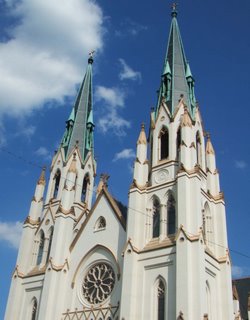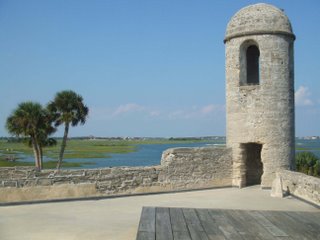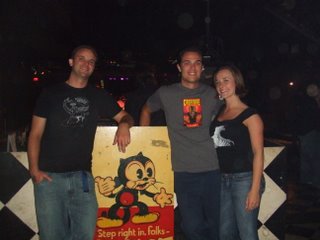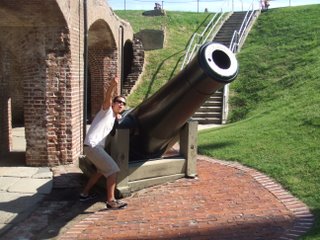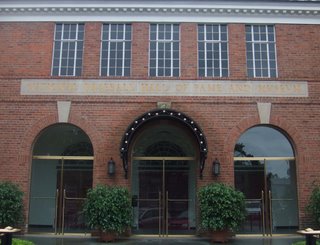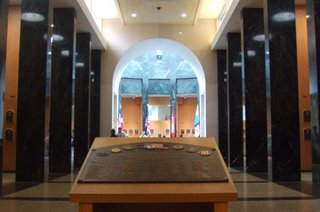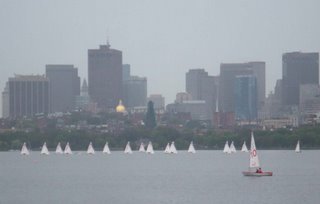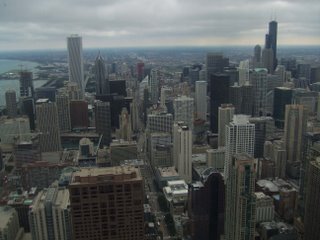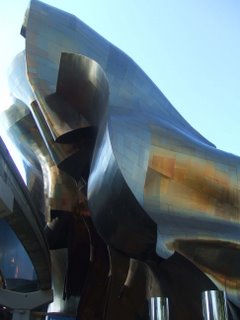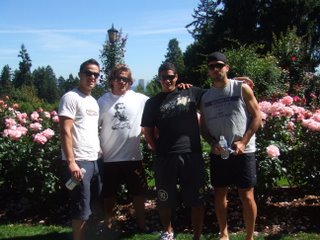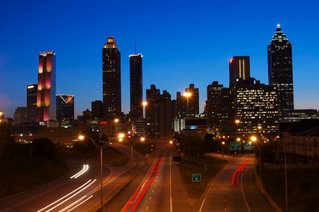 Upon arrival, I didn’t really know what to expect from the city of Atlanta. I knew that there had been a lot of urban renewal over the last few decades, and that the city was attempting to be as tourist friendly as possible, but I was somewhat at a loss when I arrived downtown in the early evening. From what I have read, Atlanta is a city that has been in a constant state of revival since post-Civil War reconstruction, but has never been able to ascend to the level desired by its residents and business. I knew that the Jimmy Carter Institute and Library and the Martin Luther King Jr. history center, birthplace, and tomb were all in the area, but beyond those few major points of interest I wasn’t sure what else would be worth the time and money to see.
Upon arrival, I didn’t really know what to expect from the city of Atlanta. I knew that there had been a lot of urban renewal over the last few decades, and that the city was attempting to be as tourist friendly as possible, but I was somewhat at a loss when I arrived downtown in the early evening. From what I have read, Atlanta is a city that has been in a constant state of revival since post-Civil War reconstruction, but has never been able to ascend to the level desired by its residents and business. I knew that the Jimmy Carter Institute and Library and the Martin Luther King Jr. history center, birthplace, and tomb were all in the area, but beyond those few major points of interest I wasn’t sure what else would be worth the time and money to see. The primary purpose of staying in Atlanta was to pick up Jesse at the airport and begin the Tennessee, Music Row, leg of the trip. I ended up staying pretty low key at the hostel just outside of downtown, eager to get some writing and resting in before our assault on Nashville. I quickly realized that this was not necessarily going to be easily achieved. The hostel, although occupying a very nice Victorian house, was situated in a fairly sketchy, and noisy, part of town. Due to this fact, a few hostellers made the room I was staying in, and the adjacent balcony, their unofficial hangout and party center instead of venturing out and finding nearby bars to carouse in. Consequently, I met, and hung out with, two guys from Liverpool, England. One of the two was being recruited by the Georgia Tech soccer team and was checking out the school for the first time. The other, a much more articulate bloke, was trying to break into acting… Who knows why he ended up in Atlanta? These two mates were absolutely hilarious, but also boarderline crazy, slightly intimidating, self-destructive, rambunctious, and for some reason beyond my explanation , exceedingly nice and talkative to me. As the evening progressed, and they put some beers into the system, their speech became nearly incomprehensible. One of the two, the non-actor, had an accent that made him sound as if he was talking with a handful of marbles in his mouth. It was quite an experience to hangout with guys who considered themselves hooligans, although they didn’t refer to themselves by that name, and freely joked about “beating the jolly fuck” out of rival fans in street and stadium fights. Although we were safely upstairs in the hostel, I felt slightly uncomfortable with the two of them yelling at people passing by, and getting rough with one another on the balcony, paying no heed to the fact that we were in an entirely black part of town and that they were two very, very white foreigners. Well, nothing significant happened, but they were certifiably loony.
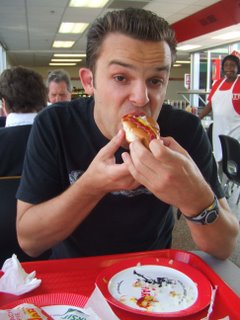 The day Jesse flew into Atlanta we ate lunch at The “World Famous” Varsity and visited the MLK Jr. Memorial and Museum. The Varsity is a huge drive-in hamburger and hotdog restaurant where, for some reason at the time we were there, all the employees were black and all the patrons were white. The best thing, by far, was the Varsity Frosted Orange, which is essentially a cream sickle in milkshake form. Delicious, but a much more hearty drink than one would expect. The chili-cheese hotdogs and hamburgers were fine, nothing special, but it was the throwback style of the place that made it a fun place to stop.
The day Jesse flew into Atlanta we ate lunch at The “World Famous” Varsity and visited the MLK Jr. Memorial and Museum. The Varsity is a huge drive-in hamburger and hotdog restaurant where, for some reason at the time we were there, all the employees were black and all the patrons were white. The best thing, by far, was the Varsity Frosted Orange, which is essentially a cream sickle in milkshake form. Delicious, but a much more hearty drink than one would expect. The chili-cheese hotdogs and hamburgers were fine, nothing special, but it was the throwback style of the place that made it a fun place to stop.Martin Luther King’s museum and neighborhood were a very interesting educational and historical experience, even though we were rushed through the museum due to a five o’ clock closing time. Within a distance of a few hundred yards, you can see MLK Jr.’s childhood home, the church where his father preached, and tomb and freedom walk that make up his final resting place. It was like being in an outdoor museum; a neighborhood filled with history that you could walk on, touch, and feel as if nothing had changed over seventy years. While standing on the opposite side of the street from King’s home, I had this feeling of wonderment wash over me. I was deeply enthused because the places I was seeing, and the ground that I was standing on, was the foundation for a sequence of events that changed history, as well as life, in this country for entire generations of people.

The decision not to stay another night in Atlanta was a question of: To Whiskey, Or Not To Whiskey? Jesse and I decided to whiskey, and I’m damn glad we did. You see, Lynchburg, the home of the one and only Jack Daniels Distillery, is not exactly on the way from Atlanta to Nashville. In fact, it is somewhat out of the way. If we had decided to stay in Atlanta for the night, a stop in Lynchburg would have been logistically impossible.
Ironically, The Jack Daniels Distillery is located in one of Tennessee’s “dry” counties— meaning that the stores, bars, and restaurants cannot sell alcohol. The only place alcohol can be purchased in the entire county is at the distillery, but honestly that’s not the real reason to go there. The main reason is the tour of the "holler," called such, because the Distillery is in a valley and you can holler from one side to the other, and its buildings, and the tour guides themselves. Our tour guide made every inch of the drive out to Lynchburg worthwhile, and he didn’t even provide us with a single drop of whiskey. He was a round, heavily bearded, overall clad man, with a deep, raspy, and hurried speaking style.
 He knew just about every tidbit of information any outsider could want to gain from an hour-long tour, and he made everyone laugh, and breathe deeply, along the way.
He knew just about every tidbit of information any outsider could want to gain from an hour-long tour, and he made everyone laugh, and breathe deeply, along the way. Tennessee is one rocking state. Who knew? I mean, I knew, but I didn’t expect it to rock to such a lofty magnitude. I’m not really sure how Tennessee, of all states, managed to put together both Memphis and Nashville, but somehow they did, and they are both really great places to visit for the musically fervent.
Nashville’s music scene is all day & night, live-band, country karaoke. The bands that play in the packed, smoke-filled bars on Broadway make sure to play everyone’s favorite country, rock, and southern rock favorites with particular attention to Lynyrd Skynyrd, Hank Jr., and Johnny Cash.
 There must be some unwritten law that states that all bands are required to know at least five Skynyrd songs just to be allowed to go up on stage, because they are inescapable. Also, the bands play for free, so they encourage both cash and alcohol tips with their crowd friendly play list and antics. Everyone’s a hollering and swallering, a whistelin’ and a yellin’. There is no shortage of girls with teased up hair and guys in cowboy hats, but the Broadway strip is also filled with tourists just trying to taste a piece of the Nashville scene. It’s a pretty addicting atmosphere, but it could definitely get old after a couple weekends. Due to the Louisville v. Middle Tennessee State football game, people were pouring out into the Nashville streets as if someone had opened up the hick hose onto Broadway. There were packs of red-clad Louisville faithful in all cracks and crevasses of the thoroughfares and bars, and they seemed to have no problem with dominating a Tennessee city. However, the game was only one contributor to the congested streets and bars of Nashville. Orange County Choppers, the custom motorbike shop of Discovery Channel fame, had set up camp on the Nashville riverside across from the football stadium, to tease bikers with their newest two-axel outputs, and provide the credibility for a few bands that badly needed support. The tickets to get into the OCC, riverside fiasco were thirty dollars, which seemed extremely steep considering the quality of music one can see in the bars a few yards down Broadway for free.
There must be some unwritten law that states that all bands are required to know at least five Skynyrd songs just to be allowed to go up on stage, because they are inescapable. Also, the bands play for free, so they encourage both cash and alcohol tips with their crowd friendly play list and antics. Everyone’s a hollering and swallering, a whistelin’ and a yellin’. There is no shortage of girls with teased up hair and guys in cowboy hats, but the Broadway strip is also filled with tourists just trying to taste a piece of the Nashville scene. It’s a pretty addicting atmosphere, but it could definitely get old after a couple weekends. Due to the Louisville v. Middle Tennessee State football game, people were pouring out into the Nashville streets as if someone had opened up the hick hose onto Broadway. There were packs of red-clad Louisville faithful in all cracks and crevasses of the thoroughfares and bars, and they seemed to have no problem with dominating a Tennessee city. However, the game was only one contributor to the congested streets and bars of Nashville. Orange County Choppers, the custom motorbike shop of Discovery Channel fame, had set up camp on the Nashville riverside across from the football stadium, to tease bikers with their newest two-axel outputs, and provide the credibility for a few bands that badly needed support. The tickets to get into the OCC, riverside fiasco were thirty dollars, which seemed extremely steep considering the quality of music one can see in the bars a few yards down Broadway for free. One performance that Jesse and I only caught a glimpse of, but wished we had witnessed in its entirety, was a Jerry Lee Lewis style piano player and his band. What we did see from the doorway of the bar they were playing in, was a vicious hammering of a defenseless keyboard with both hand and foot, and a display of energy and enthusiasm that had captivated every person in the jam-packed, narrow bar. It was a momentary, but strangely gratifying, look back at the fanatical live rockabilly shows that Jerry Lee Lewis was known for. Strangely gratifying because we almost missed the entire show, but just knowing that someone in Nashville is performing like Jerry Lee Lewis night after night is amusing and comforting to me.
You would really have to hate country music to not have an amazing time in Nashville for at least a weekend, but if you just can’t tolerate “Family Tradition” or “I Love This Bar” one more time, I’d recommend heading to Monell’s for the best southern cooking and hospitality money can buy.
 Dinner at Monell’s is a family style feast that consists of two salads, five vegetables, three meats, hot biscuits and cornbread, and saucy bread pudding to finish it off. Its exciting just writing about it. The restaurant should have a disclaimer on the door that warns people to set aside ample time afterward, because a food coma will surely follow your meal. It is a very unique dining style. Everyone waits outside on the patio or in the garden for your name to be called and table to be assigned. Once inside, each of the four large dining tables has a host that introduces the beverages & dishes, makes certain that all your needs are promptly taken care of, and strikes up table conversation throughout the meal. Once everyone is seated, the food begins to come in waves. Salads & breads. Vegetable & meats. And each time an item is polished off, the host promptly replaces it with a full bowl or basket fresh from the stove or oven. My personal favorites were the corn pudding, pulled pork, and the biscuits. The experience is more than just your typical dinner out, because it is designed to be a taste of southern culture and hospitality that becomes an afternoon activity. Between courses Jesse and I had a chance to meet the other people at our table. There was a family from a nearby city, which I forget the name of, and two girls who were down from Chicago for the weekend. The family, who also had never been to Monell’s, were stuffing their faces along with us, and sparking discussion about favorite dishes, just how many times one could refill their plate in a single sitting, and how they’d like a Monell’s to move to their city ASAP. I agreed. All cities need a Monell’s, because at the end of the dinner, filled to the gills, it only costs you sixteen dollars, and your ability to move for the rest of the evening. The girls from Chicago looked a little over-whelmed, and although pleasant, I don’t think that they ate their money's worth. I have to admit, I was in pain for the next two hours following Monell’s, but it wasn’t the kind of pain that you get from eating at a cheap Chinese buffet. It was that satisfying pain, similar to that of post-Thanksgiving glory, when all you want to do is sit, stretch and think to yourself, “I have eaten lots, and it was glorious!”
Dinner at Monell’s is a family style feast that consists of two salads, five vegetables, three meats, hot biscuits and cornbread, and saucy bread pudding to finish it off. Its exciting just writing about it. The restaurant should have a disclaimer on the door that warns people to set aside ample time afterward, because a food coma will surely follow your meal. It is a very unique dining style. Everyone waits outside on the patio or in the garden for your name to be called and table to be assigned. Once inside, each of the four large dining tables has a host that introduces the beverages & dishes, makes certain that all your needs are promptly taken care of, and strikes up table conversation throughout the meal. Once everyone is seated, the food begins to come in waves. Salads & breads. Vegetable & meats. And each time an item is polished off, the host promptly replaces it with a full bowl or basket fresh from the stove or oven. My personal favorites were the corn pudding, pulled pork, and the biscuits. The experience is more than just your typical dinner out, because it is designed to be a taste of southern culture and hospitality that becomes an afternoon activity. Between courses Jesse and I had a chance to meet the other people at our table. There was a family from a nearby city, which I forget the name of, and two girls who were down from Chicago for the weekend. The family, who also had never been to Monell’s, were stuffing their faces along with us, and sparking discussion about favorite dishes, just how many times one could refill their plate in a single sitting, and how they’d like a Monell’s to move to their city ASAP. I agreed. All cities need a Monell’s, because at the end of the dinner, filled to the gills, it only costs you sixteen dollars, and your ability to move for the rest of the evening. The girls from Chicago looked a little over-whelmed, and although pleasant, I don’t think that they ate their money's worth. I have to admit, I was in pain for the next two hours following Monell’s, but it wasn’t the kind of pain that you get from eating at a cheap Chinese buffet. It was that satisfying pain, similar to that of post-Thanksgiving glory, when all you want to do is sit, stretch and think to yourself, “I have eaten lots, and it was glorious!”  What can I say about the Country Music Hall of Fame? I was a huge fan, until I got to the end of the thing and realized that the bronze plaques commemorating the artists were, for the most part, horrible artistic depictions. The plaque makers should be shot, or at least severely beaten, for the injustice they have done to some of the country music legends. The brutal attempt to capture Elvis’ likeness fell drastically short of acceptable. Johnny Cash looked like The Thing, with a hair piece, from The Fantastic Four. This made me appreciate the elegant simplicity of the glowing signatures in The Rock and Roll Hall of Fame that much more. The exhibits, music, and collection of memorabilia were quite impressive. They had a really cool Ray Charles special exhibit dedicated to his contributions to country music. They had listening stations all over the building, and rare video footage that I easily could watch more of. It was amusing and interesting, but outdated in comparison to the other music oriented museums I have been to lately.
What can I say about the Country Music Hall of Fame? I was a huge fan, until I got to the end of the thing and realized that the bronze plaques commemorating the artists were, for the most part, horrible artistic depictions. The plaque makers should be shot, or at least severely beaten, for the injustice they have done to some of the country music legends. The brutal attempt to capture Elvis’ likeness fell drastically short of acceptable. Johnny Cash looked like The Thing, with a hair piece, from The Fantastic Four. This made me appreciate the elegant simplicity of the glowing signatures in The Rock and Roll Hall of Fame that much more. The exhibits, music, and collection of memorabilia were quite impressive. They had a really cool Ray Charles special exhibit dedicated to his contributions to country music. They had listening stations all over the building, and rare video footage that I easily could watch more of. It was amusing and interesting, but outdated in comparison to the other music oriented museums I have been to lately. The song “Jackson” which is featured in the Johnny Cash movie
 “Walk The Line” will forever confuse me. You see my brother and I went to Jackson, which is about halfway between Nashville and Memphis and attempted to go to the Rockabilly Hall of Fame. Not only was the Hall of Fame closed, but also there literally was not a person out on the downtown streets. Eerie, like a ghost town, not like a place you’d want to go party in.
“Walk The Line” will forever confuse me. You see my brother and I went to Jackson, which is about halfway between Nashville and Memphis and attempted to go to the Rockabilly Hall of Fame. Not only was the Hall of Fame closed, but also there literally was not a person out on the downtown streets. Eerie, like a ghost town, not like a place you’d want to go party in. Blues is to Memphis, as county is to Nashville. If you love live music, bar be qued ribs, Elvis, and music museums, then you will be able to find something to do while in Memphis. Memphis, however, is not the prettiest, nor safest, Southern city. Ever since Martin Luther King was assassinated in Memphis the city has been struggling with poverty, violence, and a suffering economy. It seems as if the music industry has kept the city afloat, because despite some seriously large ghettos, the Memphis music landmarks have become well maintained, run, and visited centerpieces.
 Graceland, the most famous of Memphis’ landmarks, is quite the scene. People travel from all over the world to see Elvis’ fuzzy, round bed, gold & platinum record collection, jumpsuits, and the grounds he called home. Graceland is surprisingly modest in comparison to the gargantuan, gaudy, and pompous houses of the modern rock star. Elvis had a good set-up, don’t get me wrong, with a racquetball court, horse pasture, and special themed rooms, but it wasn’t over the top. Elvis’ parents lived with him in a bedroom downstairs. He loved horses and driving around in golf carts. After seeing his childhood home in Tupelo, Mississippi I got the feeling that Elvis never lost touch with his humble roots, and although Graceland was light years away from the simplicity of his Tupelo home, it still has the feeling of a country home, even in the middle of a big city.
Graceland, the most famous of Memphis’ landmarks, is quite the scene. People travel from all over the world to see Elvis’ fuzzy, round bed, gold & platinum record collection, jumpsuits, and the grounds he called home. Graceland is surprisingly modest in comparison to the gargantuan, gaudy, and pompous houses of the modern rock star. Elvis had a good set-up, don’t get me wrong, with a racquetball court, horse pasture, and special themed rooms, but it wasn’t over the top. Elvis’ parents lived with him in a bedroom downstairs. He loved horses and driving around in golf carts. After seeing his childhood home in Tupelo, Mississippi I got the feeling that Elvis never lost touch with his humble roots, and although Graceland was light years away from the simplicity of his Tupelo home, it still has the feeling of a country home, even in the middle of a big city.Unfortunately, Jess and I hit Memphis on Sunday and Monday,
 which made for a very lethargic Beale Street scene. There were a few bands playing in the almost-always-open clubs and bars, but only a handful of people on the street. The neon was still a glowing, but the reality was that we had done a hot and heavy Nashville two nights in a row, and now it was time to digress a little on a Monday.
which made for a very lethargic Beale Street scene. There were a few bands playing in the almost-always-open clubs and bars, but only a handful of people on the street. The neon was still a glowing, but the reality was that we had done a hot and heavy Nashville two nights in a row, and now it was time to digress a little on a Monday.  Even with Beale Street playing it mellow at night, there is plenty of music history to experience during the day. Sun Studios, the launch pad of rock and roll and music legends such as Johnny Cash, Elvis, Carl Perkins, Jerry Lee Lewis, B.B. King, and many others, was an astonishingly entertaining and informative stop. The very small studio, which still records artists on a nightly basis, is only a two-room museum and gift shop, but it possesses a powerful aura. The building, although it went through some ownership changes over the years, is essentially exactly the way it was when Elvis recorded his first single, That’s All Right” in 1954. Sun Studio, coupled with STAX Records, a.k.a. “Soulsville U.S.A.,” put Memphis on the map as a music Mecca of sorts. STAX, being the home of Rufus & Carla Thomas, Otis Redding, Booker T. & The MGs, Mar-Keys, Sam & Dave, and Isaac Hayes, built a reputation as a place where Soul hits were made. Both places had that, "If only the walls could talk," feeling about them. Like Graceland, these studios were basically the homes of legends. You can walk where Johnny Cash walked when he first entered Sun, you can see the note pads that Otis Redding jotted lyrics down on during all night song writing sessions. Everything in these places is so real. It's not a movie, its not a recreation, what exists in these places is the actual history that shaped our world today. Rock and Roll. Blues. Soul. Pop culture born out of Mississippi mud.
Even with Beale Street playing it mellow at night, there is plenty of music history to experience during the day. Sun Studios, the launch pad of rock and roll and music legends such as Johnny Cash, Elvis, Carl Perkins, Jerry Lee Lewis, B.B. King, and many others, was an astonishingly entertaining and informative stop. The very small studio, which still records artists on a nightly basis, is only a two-room museum and gift shop, but it possesses a powerful aura. The building, although it went through some ownership changes over the years, is essentially exactly the way it was when Elvis recorded his first single, That’s All Right” in 1954. Sun Studio, coupled with STAX Records, a.k.a. “Soulsville U.S.A.,” put Memphis on the map as a music Mecca of sorts. STAX, being the home of Rufus & Carla Thomas, Otis Redding, Booker T. & The MGs, Mar-Keys, Sam & Dave, and Isaac Hayes, built a reputation as a place where Soul hits were made. Both places had that, "If only the walls could talk," feeling about them. Like Graceland, these studios were basically the homes of legends. You can walk where Johnny Cash walked when he first entered Sun, you can see the note pads that Otis Redding jotted lyrics down on during all night song writing sessions. Everything in these places is so real. It's not a movie, its not a recreation, what exists in these places is the actual history that shaped our world today. Rock and Roll. Blues. Soul. Pop culture born out of Mississippi mud.
The people of Tennessee know music, but they know food just as well. I know that I already sold you on Monell’s in Nashville, but there is a breakfast place in Memphis by the name of Blue Plate Café, that deserves similar recognition. You know right away that Blue Plate serves a serious breakfast when your server comes to your table with a large basket of biscuits before your order is even taken. When you do receive your order, after stuffing your face with biscuits doused with butter, you quickly realize what a horrible mistake you have made. The Denver omelet covers more than half the plate, while the rest of the plate is occupied with gigantic roasted potatoes that spill onto the table when the waitress sets the plate down. That impressive plate is supplemented by two plywood-thick pancakes that you would deny ordering if only you had the courage… Let me stop right there and tell you that there is no way a normal person should eat that much for breakfast. I was beginning to feel like everywhere I went people were playing some sick joke on me. Anyway, their slogan should be: Stop at the Blue Plate Café and you won’t have to eat for the rest of the day.

Nashville and Memphis are damn fine places to visit if you like food and music, if not, then maybe you'd like Birmingham & Montgomery, Alabama or San Antonio & Austin, Texas better, because that's where I'm heading next.

